Each application has its own disadvantages and advantages. Some of the parameters that affect the quality of applications are real-time sync, collaboration, Markdown support, fast writing, text search, image annotation, security and privacy, low cost, and other options. Let's take a closer look at the 8 best note-taking apps to help you find the perfect solution for you.
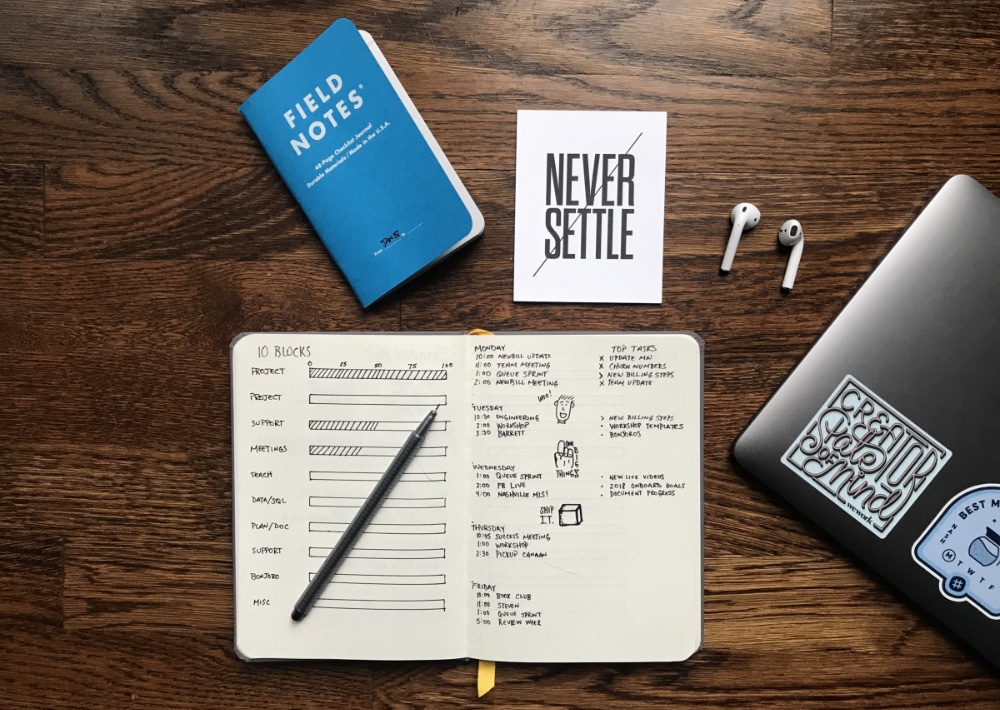
Taskade
Taskade is the place where remote teams communicate, organize and complete their tasks. It can energize your team with collaborative task lists, mind maps and more in a single workspace. Taskade is simple, beautiful, and fun.
It's a productivity app that promises to be a universal remote workspace. It's chock-full of features, has tons of customization options, and the interface resembles Trello, Notion, and even Slack.

Pros:
- Embedding documents allows you to insert previous notes into the current document and the changes will be reflected in both documents.
- The sidebar is the main tool for easy navigation.
- Fewer distractions so you can focus on work.
- .
- .
- , .
- Taskade . , . , , .
:
- , . .
- .
Platforms: Windows, macOS, Linux, Android, iOS, Web Extension.
Ideal for taking notes on iPad, for a remote enterprise thanks to tools such as assigning tasks to each member of the team, writing reports, setting deadlines, and many other tools.
Price: Taskade is free for both personal use and growing teams with up to 100MB storage. $ 5 per month will give you unlimited space.
Roam research
Over the past few weeks, I've heard about this app that is taking the productivity world by storm - Roam Research ! There is a lot of buzz around this app - it is transforming the world of notes with a bottom-up organization.
The app allows you to take notes with ease. The interface is very simple, so the saved time can be spent on organizing notes and making them beautiful. You just need to write down our ideas, and this will ultimately connect them. There is no mobile or desktop app, only a web version. There is no API access either. Import functions include JSON and Markdown.
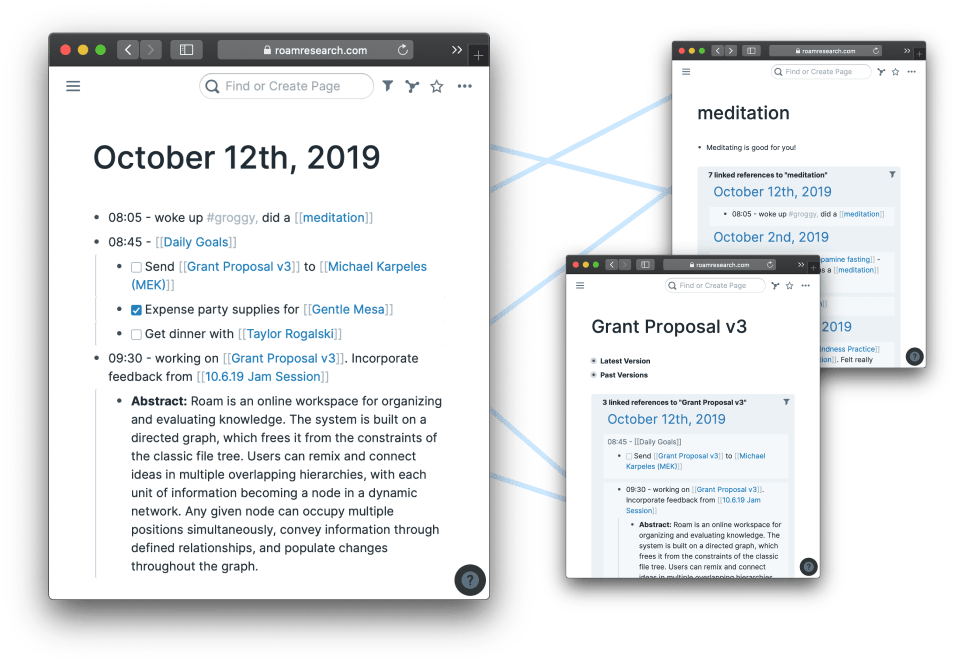
Pros:
- Underlining objects allows us to edit text in blocks.
- Fewer distractions, which helps us focus better at work.
- .
- .
- — .
- .
- , .
:
- .
- , .
Platforms: Windows, macOS, web.
Ideal for mac users, writers, and researchers.
Price: The app is free right now (although they don't appear to be accepting new users right now while working on stability issues) and they plan to charge $ 15 a month. For representatives of the scientific community, there will be a 50% discount.
Obsidian
Obsidian is a multi-pane tree-view editor that runs on top of a local folder of Markdown text files. It's more of a personal and portable option with access to 21 plugins that complement the core of the app. The absence of a mobile application forces us to limit ourselves only to a computer.
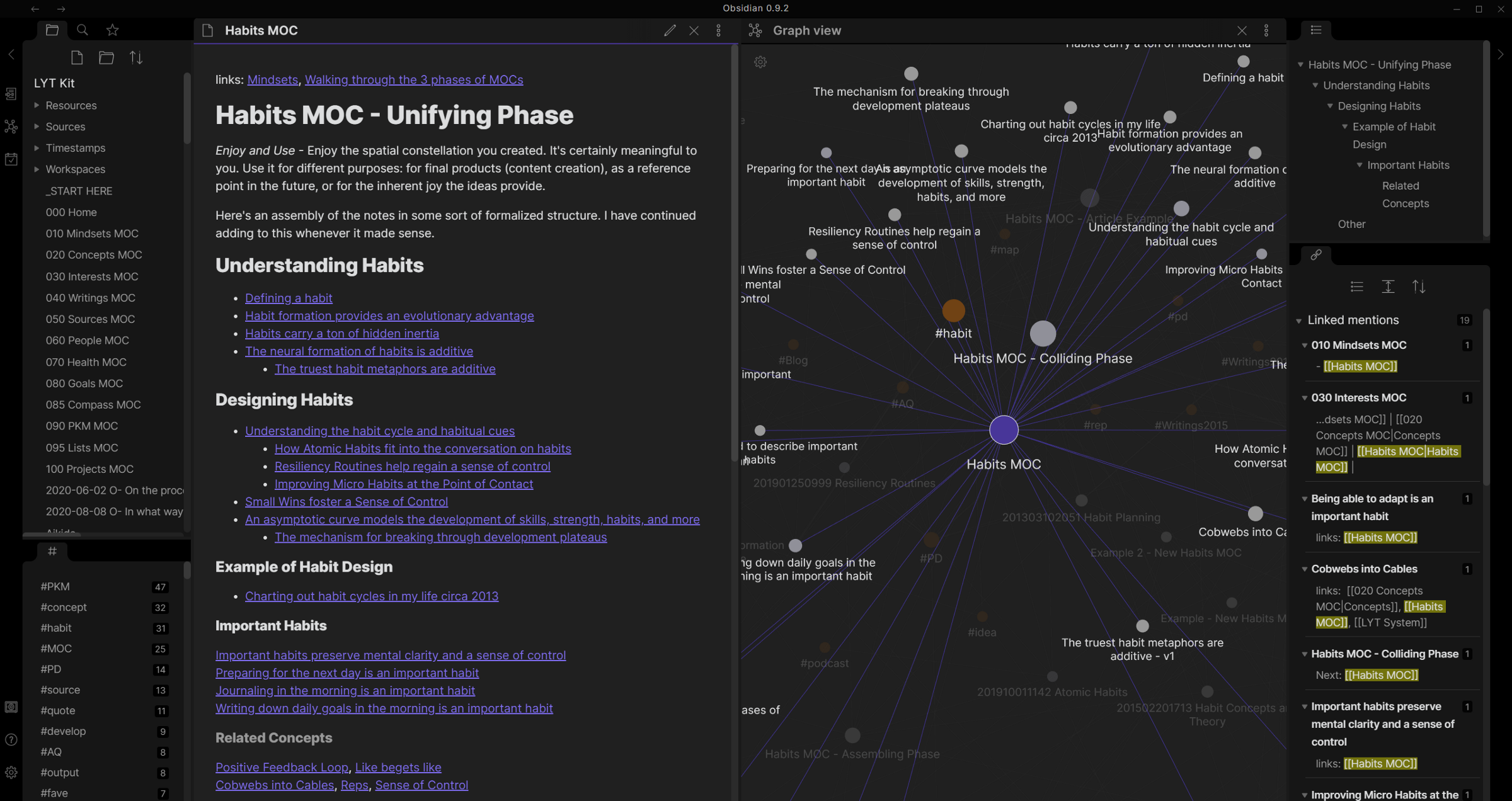
Pros:
- , Obsidian , .
- — .
- , .
- , .
- , .
- .
- , .
- , .
:
- .
Platforms: Windows, macOS, Linux.
Ideal for learning in a knowledge base, by its nature it allows you to associate the same material internally and present it in a graphical form, which is very fun and understandable.
Price: Obsidian is free for personal use of local storage, so it is always available offline. The paid version costs about $ 25 one time, which will give us early access to internal builds and developer support. The commercial version for business costs $ 50 per year.
Remnote
RemNote is the first tool that allows you to structure knowledge exactly the way you present it. This app is made for students and long term learning.
Remnote is the only app that allows you to effectively learn through both active memorization and repetition over time, as it automatically generates flash cards, which removes the time-consuming transcript of class recordings on their flash cards from the workflow. There is no mobile or desktop application, we are limited to the web or browser version only. But the API is available.
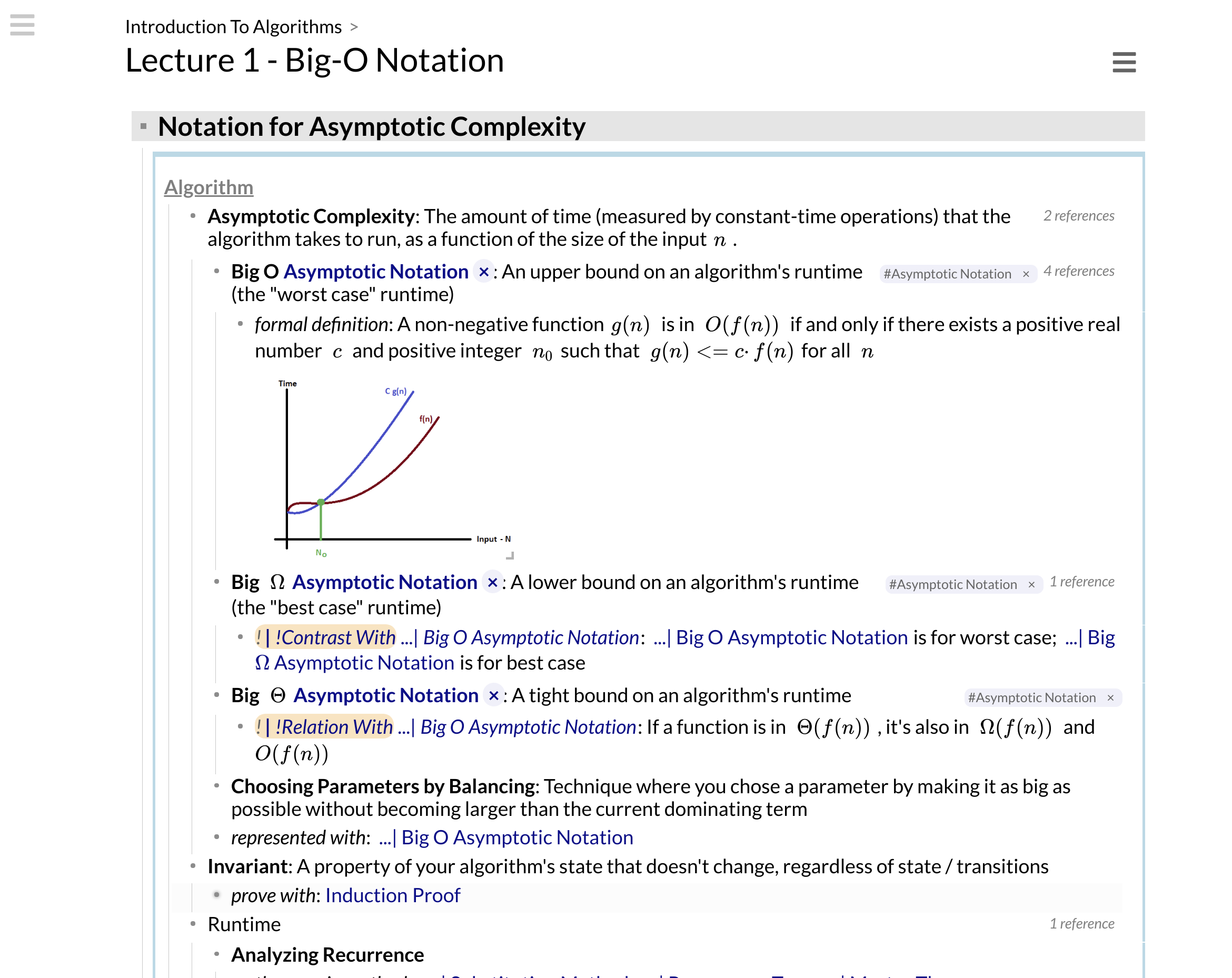
Pros:
- Embedding of documents.
- Side panel.
- Backlinks.
- There is a mobile app, but it's in early access for feedback and improvement.
- Selecting objects allows you to edit text in blocks.
- Fewer distractions than usual. This allows you to focus on your work.
Minuses:
- No desktop app.
- Collaboration has been implemented, but it's in the experimental phase.
- The tree view is kind of expected, but not currently available.
Platforms: web, unofficial version for Windows.
Ideal for taking student notes to memorize, organize, and learn.
Price: Remnote is free and promises to be free as long as it exists.
Inkdrop
Inkdrop is a Markdown-based note-taking app for software developers. It's actually written by one developer as a solution to his own recording problems. This app is similar to Evernote and Bear, but has several unique features that make it stand out and ideal for engineers. The tool is truly private, it supports end-to-end encryption.
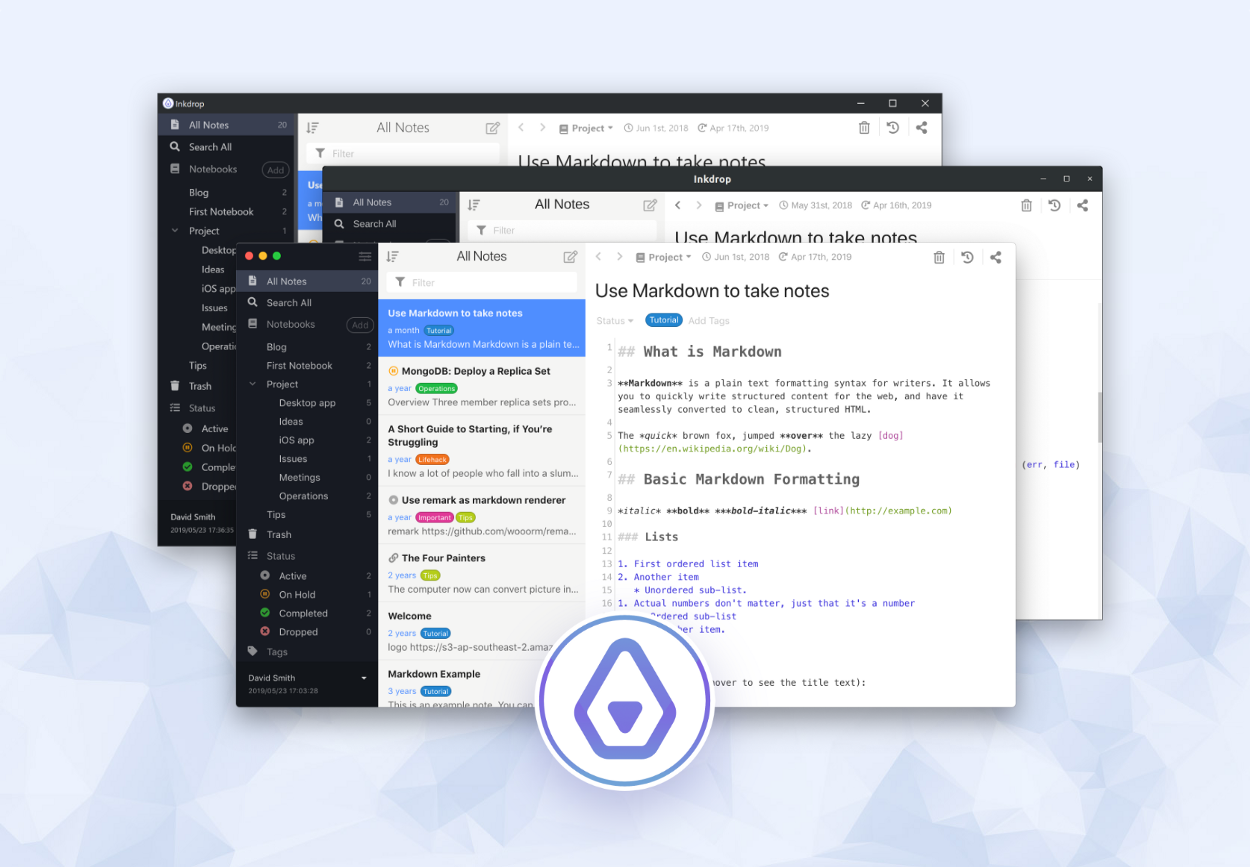
Pros:
- Fewer distractions so you can focus on work.
- Selection of objects.
- The mobile app is well optimized in terms of performance.
- Desktop application.
- Embedding of documents.
- Side panel.
- Backlinks.
Minuses:
- Collaboration is currently in an experimental phase.
- The tree view is not yet available.
Platforms: Windows, macOS, Linux, Android, iOS.
Ideal for programmers and coders because of the Markdown editor.
Price: Inkdrop is free for a 60-day trial, then you can use it for $ 5 per month. You can also get a 60% discount if you are a student or teacher.
Notion
Notion has a huge variety of note designs including tables, graphs, calendars. It's cute, with an all white design full of emojis. It has a trash can to restore an old page from history. Templates can be downloaded, making the application more suitable for collaboration. It is possible to import data from major platforms.
It is very flexible in its functionality, combining Trello, Google Drive and Evernote features. Its free option is very forgiving, you can try it without any pressure. There is a version for every device!

Pros:
- A performance-optimized mobile app.
- Collaboration, the ability to invite a team.
- Selection of objects, which allows you to edit blocks.
- Few distractions so you can focus on work.
- Desktop application.
Minuses:
- Backlinks.
- Embedding documents in development.
- A bit tricky sidebar.
- The tree view is missing: the application is focused on productivity.
Platforms: Windows, macOS, web app, Android, iOS.
Ideal for project management, teams and companies that want a better way to manage knowledge, projects and collaboration.
Price: Notion is by far the most affordable app in this segment because it's free for personal use. For power users who want more, the app costs $ 4 per month, and for a team that wants to work together centrally, it costs $ 8 per month.
Walling
In Walling can find everything you need - design Google Keep cards, minimalism Notion and philosophy Roam. It's a hybrid of Google Keep, Notion, and Roam Research. I was intrigued by the minimalist look of this app, the bottom-up organizational structure and visual format.
This app is a little different from others thanks to the unique idea of "walls" and "bricks". With Walling, it is very easy to organize your ideas and thoughts into bricks and sections, in an organized way, without feeling overwhelmed by the worries of organizing the wall.
Later, it's easy to reorganize your bricks and objects by dragging and dropping and revisiting your ideas with features like resolving bricks and sections or hiding objects.

Pros:
- Embedding of documents.
- Side panel.
- Backlinks.
- Focus on work.
- Tree view.
- Desktop application.
- Collaboration.
Minuses:
- The mobile application has not been developed yet.
Platforms: Web, Windows, macOS, Chrome Extension.
Ideal for school and university students taking notes due to its ease of use and minimalist design. This allows you to invite our friends or colleagues to the discussion walls, you can also comment on the cards individually.
Price: Walling free up to 100 "bricks". You can subscribe to Walling Premium to get unlimited bricks and walls for $ 4 per month. Walling offers team workspaces with centralized billing for $ 6 per month per team member.
Supernotes
Supernotes is a new productivity app based on note cards - small tidbits of information that can be gathered from bottom to top to formulate thoughts more fully. The more I used this app, the more and more it became a fusion of Notion and Roam - Notion's user interface and flexibility, and Roam's structure and bottom-up hierarchy.
It's all about creating notes in the form of a card, which is clearer and can be easily read when needed. You can also share the card with other people to get feedback. Cards can also link to each other, creating a hierarchy of notes.

Pros:
- Side panel.
- Backlinks.
- Collaboration.
- Fewer distractions.
Minuses:
- Functions for product management.
- The tree view is not available.
- Document embedding is not available.
- No desktop app.
- No mobile app.
- Underlining objects is not available.
Platforms: web application only.
Ideal for ready-to-go short card notes, making learning easier. This is the best note taking app for students, interns and freelancers.
Price: Supernote free up to 40 cards. You can upgrade to $ 6 per month to remove your card limit, and students can take advantage of a 50% discount on a yearly unlimited plan!
Conclusion
This was a roundup of some of the more popular, best note taking apps. I use Notion to manage my day to day tasks, and Obsidian is my second brain for collecting random ideas. Notion and Obsidian are undoubtedly the best apps for my job, even if they're not the best solution for you. I think the customization power of these modern note-taking apps is amazing and definitely worth a try.

Other professions and courses